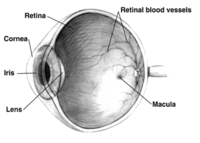
Photo from wikipedia
Summary Stem cell transplantation shows enormous potential for treatment of incurable retinal degeneration (RD). To determine if and how grafts connect with the neural circuits of the advanced degenerative retina… Click to show full abstract
Summary Stem cell transplantation shows enormous potential for treatment of incurable retinal degeneration (RD). To determine if and how grafts connect with the neural circuits of the advanced degenerative retina (ADR) and improve vision, we perform calcium imaging of GCaMP5-positive grafts in retinal slices. The organoid-derived C-Kit+/SSEA1− (C-Kit+) retinal progenitor cells (RPCs) become synaptically organized and build spontaneously active synaptic networks in three major layers of ADR. Light stimulation of the host photoreceptors elicits distinct neuronal responses throughout the graft RPCs. The graft RPCs and their differentiated offspring cells in inner nuclear layer synchronize their activities with the host cells and exhibit presynaptic calcium flux patterns that resemble intact retinal neurons. Once graft-to-host network is established, progressive vision loss is stabilized while control eyes continually lose vision. Therefore, transplantation of organoid-derived C-Kit+ RPCs can form functional synaptic networks within ADR and it holds promising avenue for advanced RD treatment.
Journal Title: Stem Cell Reports
Year Published: 2021
Link to full text (if available)
Share on Social Media: Sign Up to like & get
recommendations!